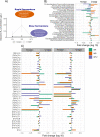The effect of 3-nitrooxypropanol, a potent methane inhibitor, on ruminal microbial gene expression profiles in dairy cows
- PMID: 36100950
- PMCID: PMC9469553
- DOI: 10.1186/s40168-022-01341-9
The effect of 3-nitrooxypropanol, a potent methane inhibitor, on ruminal microbial gene expression profiles in dairy cows
Abstract
Background: Enteric methane emissions from dairy cows are an environmental problem as well as a gross feed energy loss to the animal. Methane is generated in the rumen by methanogenic archaea from hydrogen (H2) + carbon dioxide and from H2 + methanol or methylamines. The methanogenic substrates are provided by non-methanogens during feed fermentation. Methane mitigation approaches have yielded variable results, partially due to an incomplete understanding of the contribution of hydrogenotrophic and methylotrophic archaea to methanogenesis. Research indicates that 3-nitrooxypropanol (3-NOP) reduces enteric methane formation in dairy cows by inhibiting methyl-coenzyme M reductase (MCR), the enzyme responsible for methane formation. The purpose of this study was to utilize metagenomic and metatranscriptomic approaches to investigate the effect of 3-NOP on the rumen microbiome and to determine the fate of H2 that accumulates less than expected under inhibited methanogenesis.
Results: The inhibitor 3-NOP was more inhibitory on Methanobrevibacter species than methanol-utilizing Methanosphaera and tended to reduce the gene expression of MCR. Under inhibited methanogenesis by 3-NOP, fluctuations in H2 concentrations were accompanied by changes in the expression of [FeFe] hydrogenases in H2-producing bacteria to regulate the amount of H2 production. No previously reported alternative H2 sinks increased under inhibited methanogenesis except for a significant increase in gene expression of enzymes involved in the butyrate pathway.
Conclusion: By taking a metatranscriptomic approach, this study provides novel insights on the contribution of methylotrophic methanogens to total methanogenesis and regulation of H2 metabolism under normal and inhibited methanogenesis by 3-NOP in the rumen. Video Abstract.
Keywords: Enteric methane; Hydrogenases; Methane mitigation; Ruminal methanogenesis; Total and metabolically active microbes.
© 2022. The Author(s).
Conflict of interest statement
SD, MK, and NW are employees of DSM Nutritional Products. The other authors declare no competing interests.
Figures





Similar articles
-
Temporal changes in total and metabolically active ruminal methanogens in dairy cows supplemented with 3-nitrooxypropanol.J Dairy Sci. 2021 Aug;104(8):8721-8735. doi: 10.3168/jds.2020-19862. Epub 2021 May 21. J Dairy Sci. 2021. PMID: 34024597
-
Synergistic Effects of 3-Nitrooxypropanol with Fumarate in the Regulation of Propionate Formation and Methanogenesis in Dairy Cows In Vitro.Appl Environ Microbiol. 2022 Mar 22;88(6):e0190821. doi: 10.1128/AEM.01908-21. Epub 2022 Jan 26. Appl Environ Microbiol. 2022. PMID: 35080908 Free PMC article.
-
Symposium review: Understanding the role of the rumen microbiome in enteric methane mitigation and productivity in dairy cows.J Dairy Sci. 2022 Oct;105(10):8569-8585. doi: 10.3168/jds.2021-21466. Epub 2022 Mar 26. J Dairy Sci. 2022. PMID: 35346473 Review.
-
Differential alteration of rumen microbial composition in response to 3-nitrooxypropanol supplementation in dairy cattle fed high-grain and high-forage diets.J Dairy Sci. 2025 Aug;108(8):8313-8331. doi: 10.3168/jds.2024-26206. Epub 2025 May 16. J Dairy Sci. 2025. PMID: 40383387
-
[Methanogens and manipulation of methane production in the rumen].Wei Sheng Wu Xue Bao. 2005 Feb;45(1):145-8. Wei Sheng Wu Xue Bao. 2005. PMID: 15847184 Review. Chinese.
Cited by
-
Effects of type of substrate and dilution rate on fermentation in serial rumen mixed cultures.Front Microbiol. 2024 Feb 9;15:1356966. doi: 10.3389/fmicb.2024.1356966. eCollection 2024. Front Microbiol. 2024. PMID: 38389534 Free PMC article.
-
A review of key microbial and nutritional elements for mechanistic modeling of rumen fermentation in cattle under methane-inhibition.Front Microbiol. 2024 Nov 21;15:1488370. doi: 10.3389/fmicb.2024.1488370. eCollection 2024. Front Microbiol. 2024. PMID: 39640851 Free PMC article. Review.
-
Assessing the Impact of the Methane Inhibitors 3-Nitrooxypropanol (3-NOP) and Canola Oil on the Rumen Anaerobic Fungi.Animals (Basel). 2025 Apr 27;15(9):1230. doi: 10.3390/ani15091230. Animals (Basel). 2025. PMID: 40362045 Free PMC article.
-
Distinct microbial hydrogen and reductant disposal pathways explain interbreed variations in ruminant methane yield.ISME J. 2024 Jan 8;18(1):wrad016. doi: 10.1093/ismejo/wrad016. ISME J. 2024. PMID: 38365243 Free PMC article.
-
Connecting the ruminant microbiome to climate change: insights from current ecological and evolutionary concepts.Front Microbiol. 2024 Dec 2;15:1503315. doi: 10.3389/fmicb.2024.1503315. eCollection 2024. Front Microbiol. 2024. PMID: 39687868 Free PMC article. Review.
References
-
- Intergovernmental Panel on Climate Change. Summary for policy makers of IPCC special report on global warming of 1.5°C approved by governments [Internet]. 2018. Available from: https://www.ipcc.ch/2018/10/08/summary-for-policymakers-of-ipcc-special-.... Cited2/17/22.
-
- Gerber PJ, Steinfeld H, Henderson B, Mottet A, Opio C, Dijkman J, et al. Tackling climate change through livestock – a global assessment of emissions and mitigation opportunities [Internet]. Food and Agriculture Organization of the United Nations (FAO), Rome. 2013. Available from: https://www.fao.org/3/i3437e/i3437e.pdf. Cited 1/12/22.
-
- Saunois M, Bousquet P, Poulter B, Peregon A, Ciais P, Canadell JG, et al. The global methane budget 2000–2012. Earth Syst. Sci. Data. 2016;8(2):697–751. doi: 10.5194/essd-8-697-2016. - DOI
-
- Hristov AN, Oh J, Firkins JL, Dijkstra J, Kebreab E, Waghorn G, Makkar HP, Adesogan AT, Yang W, Lee C, Gerber PJ. Special topics—mitigation of methane and nitrous oxide emissions from animal operations: I. A review of enteric methane mitigation options. J Anim Sci. 2013;91(11):5045–5069. doi: 10.2527/jas.2013-6583. - DOI - PubMed
Publication types
MeSH terms
Substances
LinkOut - more resources
Full Text Sources
Other Literature Sources
Molecular Biology Databases

